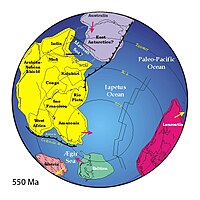Proto-Tethys


The Proto-Tethys was a geological ocean and existed from the uppermost Ediacarium ~ 550 mya to the middle Carboniferous ~ 320 mya.
The forerunner of the later Palaeotethys formed when the briefly existing global supercontinent Pannotia broke up, the fragment of Proto- Laurasia drifted away from Gondwana in the global ocean Panthalassa, making this sea area distinguishable. At the same time, the Rhine Ocean also existed as a partial sea between Gondwana and the small continent Avalonia, which was migrating north .
Only a few million years later, at the beginning of the Paleozoic Era , Proto-Laurasia divided into its constituents and thereby opened the Iapetus between Laurentia and Baltica and the Khanty-Mansi Ocean between Baltica and Sibiria .
The ocean was delimited from the northern Panthalassa by island arches and the Kazakh craton .
The Proto-Tethys spread during the Cambrian and reached its greatest extent in the lower Silurian ~ 440 mya.
Sibiria was in the west, Gondwana in the east of the ocean while in the Upper Silurian North and South China broke away from Gondwana and moved north. In the upper Devonian, the Kazakhstan clod collided with Siberia, thereby limiting the ocean. The final closure with the formation of the suture took place through the annexation of northern China to the now almost complete Eurasia - Laurussia with Kazakhstan and Siberia around 300 mya, in the uppermost Carboniferous , while the Palaeotethys was now created by the breaking away of the Cimmerian cratons from Gondwana. From this time of the Carbon - Permian border ~ 300 mya, the last global supercontinent Pangea is considered complete.
Web links
See also
Individual evidence
- ↑ Helmut W. Flügel: The Paleozoic Tethys: Facts, Fictions, Questions. Mitt. Austrian geol. Ges. 74/75 1981/82 pp. 83-100. P. 90 (PDF; 1.3 MB)
- ^ Shadows of old continents ( Memento from August 28, 2011 in the Internet Archive )
- ↑ The world in the Silurian - 425 mya .
- ↑ Note: The terminology and chronology is largely inconsistent and confusing even for experts, so there is often no distinction between Proto-Tethys, Palaeotethys , Tethys and Paratethys , although these four Tethys seas span several hundred million years of geological history.